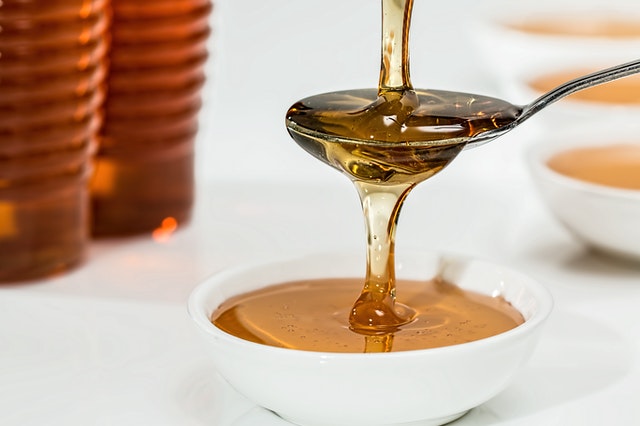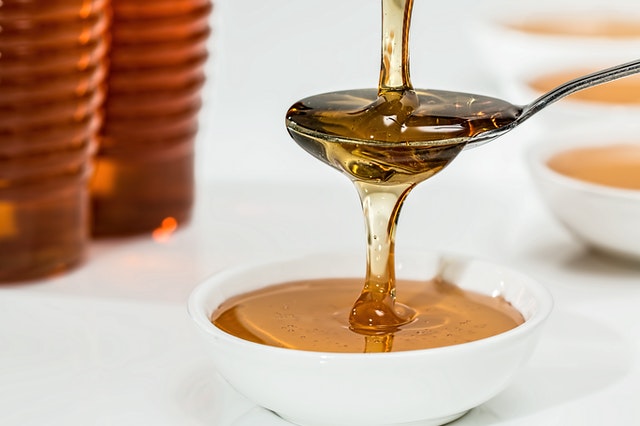
4 Types of Honey - Pure, Raw, Wild, Natural
Honey has been used in our daily diet for thousands of years. It’s a great natural sweetener and beauty aid.
Did you know there are up to 300 varieties of honey in this world? From these, the forms of honey found in the market are further broken down into liquid, comb honey, cut comb honey in liquid, natural, crystallized and whipped. What’s your favourite type of honey? Read on to find out more!
What Are The 4 Types Of Honey?
Pure Honey
Pure honey is derived from a honeycomb so only the clear, liquid form is extracted. This is the core process of beekeeping. The bees store honey in cells that are capped in beeswax and honey is extracted manually with a heated knife from moveable frame hives or by a machine. The waxy beehive cells are left intact for the bees to make more honey. The organic honey sold in health stores are pure, unpasteurized honey.

Raw Honey
Raw honey is extracted "as is" from the beehive. This is done through the “crush and strain” method. Once strained, the honey is ready to be eaten.
Raw honey is honey with no additives. The texture of raw honey is unique. Raw honey comes directly from the hive with the honeycomb intact and wax from it is visible, giving it a cloudy, unrefined look.
This type of honey should be consumed as soon as possible as it has not been monitored for moisture content. With an unchecked high moisture content, it will not have a long shelf life.
Regular honey, on the other hand, goes through a pasteurization process to extend its shelf life. However, the flavour of the honey may be compromised. Many experts also believe that this process may destroy helpful nutrients and antioxidants in the honey. Regular honey may contain additives like sugar or corn syrup.
Wild Honey
Wild honey is found in a jungle or forest and is created by nomadic bees which are not members of a controlled colony. There is no monitoring of the hive and no way of determining the age of the honey batch. The taste will vary as the nectar source cannot be determined.
The texture of wild honey is cloudier. It may be crystallised and contain particles of bee pollen, propolis, honeycomb and even bits of bee wings.
Natural Honey
Natural honey is honey that is derived from honey bees and not synthetically manufactured in a laboratory. Pure honey, natural honey and wild honey fall under the same category as they are minimally processed and do not go through a pasteurization process.
Why are there different types of honey?
There are different types of honey because they are collected by bees from different nectar sources. The flowers will give the honey its unique taste. There are different colors of honey as well, which can range from delicate gold to dark, murky brown.
Honey can include exotic varieties like pumpkin blossom honey, clover honey, wildflower honey and highly coveted honey like clover and buckwheat.
Flavours of honey vary from delicate, malty, a tinge of sour to slightly bitter. Unique honey flavours include buckwheat honey, alfalfa honey, basswood honey and sourwood honey and pumpkin blossom honey.
How Is honey collected and processed?
Source Of Collecting Nectar
Honey is collected from a nectar source of flowers that attract bees and other animals like butterflies and hummingbirds. Beekeepers grow certain flowering plants like clover or buckwheat to make specialized honeys which command a special price.
The bees will collect nectar from these flowers and then fly back to their hives to create honey. Bees create honey because it is their natural food. Bees tend to fly up to a maximum of six kilometers so they can forage from a remote nectar source. The returning bees will chew the nectar up. The nectar then gets broken down into simple sugars and are stored inside the honeycomb wax cells.
If you observe a bee, you will notice that the bees’ wings are constantly flapping, thus causing the sugar and the wax to evaporate to create liquid honey.
Honey Processing
Honey is processed from the following three processes:
Comb Honey
Bees build honeycombs in order to store honey which is naturally capped to seal off moisture. Comb honey is created when bees are given foundationless frames rather than the normal bee frames with support. They will build their own cell-like combs to store their honey.
Bees produce more honey during the season of maximum nectar flow Beekeepers will usually remove the old honeycombs to make way for new ones during this season as the bees continue to create the wax chambers..
This method also allows pieces of full comb honey to be placed in the jar as an ornamental display. This style of honey presentation is priced by honey connoisseurs and foodies.
Honey By Extraction
The first step in the extraction process is to break the caps manually or through an automated capping machine. The bits of wax still found in the honey is further refined and drained for waxed products like beeswax candles.
During this process, the bee propolis, which has medicinal value, is also harvested. Propolis is the bee glue that honeybees produce by mixing saliva with beeswax. Bees use it as a sealant to create cells in the beehive.
The honey frames are then placed in a honey extractor machine that removes the wax sediments by a spinning, centrifugal force. This rotating and spinning action extracts the honey at a regulated speed. The honey extractor machine can be either tangential or radial in set up. The tangential design empties one side of a frame at a time and then is flipped over to empty the other side. The radial model allows the worker to insert smaller honey frames. This machine empties honey from both sides of the frame at the same time without having to stop the machine.
This process will allow the honey to flow into a storage container. It is then strained again to refine the honey. A moisture check is done to ensure that the honey contains less than 17% water. The honey will then be graded and bottled for sale.
Crush and Strain Method
The crush and strain method is a manual way of separating the honey from the beeswax. The process starts by crushing the honey-laden comb, mashing it up and straining it through a cheesecloth. The composite is then covered with a cloth and allowed to sit in the bowl for a day or two so that all the honey is collected properly. This will separate the honey from the beeswax.
What is the rarest honey type?
The rarest honey type in the world is honey made by giant Himalayan bees called Apis Dorsata. The honey is called mad honey or hallucinogenic honey. Mad honey has a dark, reddish colour and is slightly bitter. It comes from Nepal and Turkey. The honey has medicinal properties and may cause hallucinations, a slower heartbeat, temporary paralysis or unconsciousness.
Uses of Honey
There are many uses of Honey, which includes treating burns, improving memory, treating herpes, managing diabetes, treating cancer, curing haemorrhoids, treating wounds and ulcers, enhancing fertility and psoriasis. For weight loss, clover honey is good for you. Clover honey is sweet with a mildly floral taste. It is rich in minerals and antioxidants. The best honey brand for weight loss is honey that can act as a sugar substitute.
Which type of honey is best?
There are about 300 honey varieties in the world. The honey that is best for you would depend on your purpose of taking the honey. There are also some best honey for tea. There are medicinal honey varieties if you wish to improve your health. One of the most sought after honey for its antibacterial agents is manuka honey. Produced in New Zealand from the flowers of the Tea Tree bush, manuka honey is especially effective in healing wounds and diabetic ulcers and a whole host of health benefits. To know more, click here for FAQs on Manuka Honey.
The four types of honey discussed above will have given you a good idea on selecting the right honey types suitable for your lifestyle and nutritional needs.
References
Combe, Liv “9 Unexpected Uses Of Honey” (23 January, 2017) [Accessed 9 July, 2020] https://www.healthline.com/health/9-unexpected-uses-for-honey#takeaway
“What is Clover Honey? Uses, Nutrition and Benefits https://www.healthline.com/nutrition/clover-honey#origin-and-uses [Accessed 9 July, 2020]
“Extracting Honey” Scienceonline.com (18 September, 2013) https://www.youtube.com/watch?v=AfC1JBGx2TY [Accessed 9 July, 2020]
“Forest Honey” Kerala Forests and Wildlife Department [Accessed 9 July, 2020] http://www.forest.kerala.gov.in/index.php/vanasree/forest-honey#:~:text=Apis%20cerana%20indica%2C%20are%20small,of%206%2D8%20per%20colony.
“Honey Types” https://www.researchgate.net/publication/304011787_Honey_Types
Lovely Greens.com: “Harvesting Honey: The Crushing and Straining Method” (17 June, 2016) https://www.youtube.com/watch?v=liUwbNw2XIg [Accessed 9 July, 2020]
“Ritual and Medicinal Mad Honey: This hallicinogenic honey can sell for over $60 on the black market” https://www.atlasobscura.com/foods/mad-honey-red-hallucinogen [Accessed 9 July, 2020]
“Nectar Source” https://en.wikipedia.org/wiki/Nectar_source [Accessed 9 July, 2020]
“Propolis” https://en.wikipedia.org/wiki/Propolis [Accessed 9 July, 2020]
Raman, Ryan “All About Raw Honey: How Is It Different Than Regular Honey?” (20 January, 2018) https://www.healthline.com/nutrition/raw-honey-vs-regular#section7 [Accessed 9 July, 2020]
“”Varieties Of Natural Honey” Agricultural & Processed Food Products Export Development Authority (APEDA) Ministry of Commerce & Industry, Government Of India [Accessed 9 July, 2020] http://apeda.gov.in/apedawebsite/SubHead_Products/Natural_Honey.htm#:~:text=Varieties%3A,major%20varieties%20of%20Natural%20Honey.
Wyatt, Leslie J., 19 June, 2015, 3 Ways To Harvest Honey, https://www.hobbyfarms.com/3-ways-to-harvest-honey-4/ [Accessed 9 July, 2020]


Leave a comment